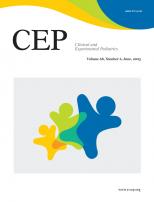Children today are growing up in environments in which interactive screen-based activities are readily available. When smart devices are appropriately utilized according to a child's developmental stage, they may offer significant developmental benefits and oppertunities [1]. The unprecedented rise in screen time has raised concerns about its potential impact on neurodevelopment, leading to tremendous research interest over the last decade to define an appropriate level of media usage.
Ongoing studies are evaluating the impact of excessive screen time on emotional, behavioral, cognitive, and physical issues [2]. Notably, excessive screen time is strongly associated with autism spectrum disorder and language delays. In 2022, Kushima et al. [3] reported that 1-year-old boys with more than 2 hr/day of screen time were more likely to develop autism-like symptoms by 3 years of age. A population-based cross-sectional study in India reported that longer screen time was associated with developmental delays, particularly in language acquisition and communication skills, in children younger than 5 years [4].
The American Academy of Pediatrics (AAP) recommends avoiding media exposure for children younger than 2 years and limiting screen time to less than 1 hr/day for those aged 2–5 years [1]. The Healthy Media Plan in Family published by the AAP emphasizes the importance of parental guidance in creating screen-free zones, increasing screen-free times, and having a “one screen at a time” rule. Appropriate media use supported by high-quality content and parental involvement can positively stimulate a child's cognitive, linguistic, and social development. Parental media-related behavior is a significant predictor of unhealthy media-related habits in their children; thus, an individualized approach based on a child’s age and developmental stage is essential. Global guidelines from the World Health Organization emphasize the importance of similar limits [5].
In Korea, insufficient research emphasis and social recognition have been directed toward the detrimental effects of excessive screen time on preschoolers. In 2018, Lee et al. reported a mean 138 min/day of screen time for Korean children aged 3–5 years and that excessive media exposure was linked to an increased risk of language delays [6]. The Korean Pediatric Society recently introduced comprehensive digital guidelines aimed at supporting Korean parents' management of their children’s digital media usage. These guidelines detail the potential adverse effects of media exposure by age group and suggest effective digital media education methods. For preschoolers, this includes practical approaches to promoting screen-free physical activity [7].
In 2024, Lee et al. [8] systematically reviewed 36 studies published in 2010–2019 that evaluated the individual, familial, and environmental factors affecting preschoolers' screen time. They concluded that healthy parental media-related habits and limitations on children’s screen time were the most crucial factors in reducing media exposure. This study underscores the protective factors that promote healthy media habits and the aggravating factors contributing to increased screen time, offering a broad perspective of the importance of parenting and the environment (Table 1). One important protective factor was nearby green spaces such as parks. Short walking distances from home to green areas were associated with a significantly reduced screen time. In addition, high-quality TV programs offered by public broadcasting services can positively influence children’s cognition and social interactions. However, this review lacked an in-depth analysis of the relative importance of each factor. Excluding post-2019 studies, particularly those covering the coronavirus disease 2019 (COVID-19) pandemic, is another limitation.
The pandemic led to increased screen time owing to restricted outdoor activities and school attendance. During the COVID-19 pandemic in Canada, studies examined the developmental impact of screen time on children. The mean screen time of children aged 2–5 years was 3.44 hr/day [9]. Children who used screens intensively (>4 hr/day) had a higher risk of global developmental delays than light users (0–1 hr/day) during the pandemic [10].
Current evidence highlights several modifiable risk factors that contribute to excessive screen time, including unhealthy parental media-related habits, mealtime media use, lacking parental guidelines, and lacking outdoor activities (Table 1). The modification of these risk factors requires parental guidance and involvement that supports limited media exposure. For younger children, appropriate interactions with their parents while using smart devices are especially important for optimizing their language development.
In Korea, the Infant and Toddler Health Screening Program offers 8 primary care check-ups before school age. During these visits, parents should receive education on healthy media use, including watching media with their children, avoiding screen time during meals and at bedtime, and limiting their children's screen time to beneficial content only.
Currently available studies of media exposure often fail to control single influencing factors and accurately measure screen time. Given the already overwhelming and increasing accessibility of digital media, understanding how media exposure impacts various developmental domains is crucial. Future multicenter or government-supported studies should explore the long-term effects of digital media exposure on cognitive and mental health to inform public health policies and improve children’s developmental outcomes.





 PDF Links
PDF Links PubReader
PubReader ePub Link
ePub Link PubMed
PubMed Download Citation
Download Citation


